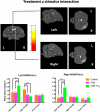Topography and Lateralized Effect of Acute Aromatase Inhibition on Auditory Processing in a Seasonal Songbird
- PMID: 28314822
- PMCID: PMC6596569
- DOI: 10.1523/JNEUROSCI.1961-16.2017
Topography and Lateralized Effect of Acute Aromatase Inhibition on Auditory Processing in a Seasonal Songbird
Abstract
It is increasingly recognized that brain-derived estrogens (neuroestrogens) can regulate brain physiology and behavior much faster than what was previously known from the transcriptional action of estrogens on nuclear receptors. One of the best examples of such neuromodulation by neuroestrogens concerns the acute regulation of sensory coding by the auditory cortex as demonstrated by electrophysiological studies of selected neurons in zebra finches. Yet, the spatial extent of such modulation by neuroestrogens is not known. Using functional magnetic resonance imaging, we demonstrate here that acute estrogen depletion alters within minutes auditory processing in male European starlings. These effects are confined to very specific but large areas of the auditory cortex. They are also specifically lateralized to the left hemisphere. Interestingly, the modulation of auditory responses by estrogens was much larger (both in amplitude and in topography) in March than in December or May/June. This effect was presumably independent from changes in circulating testosterone concentrations since levels of the steroid were controlled by subcutaneous implants, thus suggesting actions related to other aspects of the seasonal cycle or photoperiodic manipulations. Finally, we also show that estrogen production specifically modulates selectivity for behaviorally relevant vocalizations in a specific part of the caudomedial nidopallium. These findings confirm and extend previous conclusions that had been obtained by electrophysiological techniques. This approach provides a new very powerful tool to investigate auditory responsiveness in songbirds and its fast modulation by sex steroids.SIGNIFICANCE STATEMENT Neuroestrogens can acutely modulate sensory processing in a manner similar to neuromodulators. We report that acute estrogen depletion rapidly disrupts auditory processing in large areas of the male starling brain. Effects were larger in March than in December or May/June, lateralized to the left hemisphere and specific to behaviorally relevant stimuli. These findings confirm and extend previous data that identified an acute regulation of auditory neurons in zebra finches by (1) delineating the extent of the brain region affected, (2) confirming its lateralization, and (3) demonstrating that a large part of the auditory brain regions are acutely affected by estrogens. These findings provide a very powerful tool to investigate auditory responsiveness in songbirds and its fast modulation by sex steroids.
Keywords: European starling; NCM; fMRI; lateralization; rapid estrogen action.
Copyright © 2017 the authors 0270-6474/17/374243-12$15.00/0.
Figures








Comment in
-
Estradiol Modulates Hemispheric Lateralization of Auditory Evoked Neural Activity in Male European Starlings (Sturnus vulgaris).J Neurosci. 2017 Aug 16;37(33):7800-7802. doi: 10.1523/JNEUROSCI.1414-17.2017. J Neurosci. 2017. PMID: 28821600 Free PMC article. No abstract available.
Similar articles
-
Rapid changes in auditory processing in songbirds following acute aromatase inhibition as assessed by fMRI.Horm Behav. 2018 Aug;104:63-76. doi: 10.1016/j.yhbeh.2018.03.011. Epub 2018 Apr 7. Horm Behav. 2018. PMID: 29605635 Review.
-
Neuroestrogen signaling in the songbird auditory cortex propagates into a sensorimotor network via an 'interface' nucleus.Neuroscience. 2015 Jan 22;284:522-535. doi: 10.1016/j.neuroscience.2014.10.023. Epub 2014 Oct 19. Neuroscience. 2015. PMID: 25453773 Free PMC article.
-
Sensory Coding and Sensitivity to Local Estrogens Shift during Critical Period Milestones in the Auditory Cortex of Male Songbirds.eNeuro. 2017 Dec 12;4(6):ENEURO.0317-17.2017. doi: 10.1523/ENEURO.0317-17.2017. eCollection 2017 Nov-Dec. eNeuro. 2017. PMID: 29255797 Free PMC article.
-
Testosterone synthesis in the female songbird brain.Horm Behav. 2020 May;121:104716. doi: 10.1016/j.yhbeh.2020.104716. Epub 2020 Feb 28. Horm Behav. 2020. PMID: 32061616 Free PMC article.
-
Neuroestrogens rapidly shape auditory circuits to support communication learning and perception: Evidence from songbirds.Horm Behav. 2018 Aug;104:77-87. doi: 10.1016/j.yhbeh.2018.03.007. Epub 2018 Mar 30. Horm Behav. 2018. PMID: 29555375 Free PMC article. Review.
Cited by
-
De Novo Synthesized Estradiol: A Role in Modulating the Cerebellar Function.Int J Mol Sci. 2020 May 7;21(9):3316. doi: 10.3390/ijms21093316. Int J Mol Sci. 2020. PMID: 32392845 Free PMC article. Review.
-
Aromatase and nonaromatase neurons in the zebra finch secondary auditory forebrain are indistinct in their song-driven gene induction and intrinsic electrophysiological properties.Eur J Neurosci. 2021 Nov;54(9):7072-7091. doi: 10.1111/ejn.15463. Epub 2021 Oct 7. Eur J Neurosci. 2021. PMID: 34535925 Free PMC article.
-
Uncovering a 'sensitive window' of multisensory and motor neuroplasticity in the cerebrum and cerebellum of male and female starlings.Elife. 2021 Jun 7;10:e66777. doi: 10.7554/eLife.66777. Elife. 2021. PMID: 34096502 Free PMC article.
-
New concepts in the study of the sexual differentiation and activation of reproductive behavior, a personal view.Front Neuroendocrinol. 2019 Oct;55:100785. doi: 10.1016/j.yfrne.2019.100785. Epub 2019 Aug 17. Front Neuroendocrinol. 2019. PMID: 31430485 Free PMC article. Review.
-
Adult auditory brain responses to nestling begging calls in seasonal songbirds: an fMRI study in non-parenting male and female starlings (Sturnus vulgaris).Front Behav Neurosci. 2024 Sep 17;18:1418577. doi: 10.3389/fnbeh.2024.1418577. eCollection 2024. Front Behav Neurosci. 2024. PMID: 39355542 Free PMC article.
References
-
- Apfelbeck B, Mortega K, Kiefer S, Kipper S, Vellema M, Villavicencio CP, Gahr M, Goymann W (2013) Associated and disassociated patterns in hormones, song, behavior and brain receptor expression between life-cycle stages in male black redstarts, Phoenicurus ochruros. Gen Comp Endocrinol 184:93–102. 10.1016/j.ygcen.2012.11.027 - DOI - PubMed
-
- Ball GF, Wingfield JC (1987) Changes in plasma levels of sex steroids in relation to multiple broodedness and nest site density in male starlings. PhysiolZool 60:191–196.
Publication types
MeSH terms
Substances
LinkOut - more resources
Full Text Sources
Other Literature Sources
